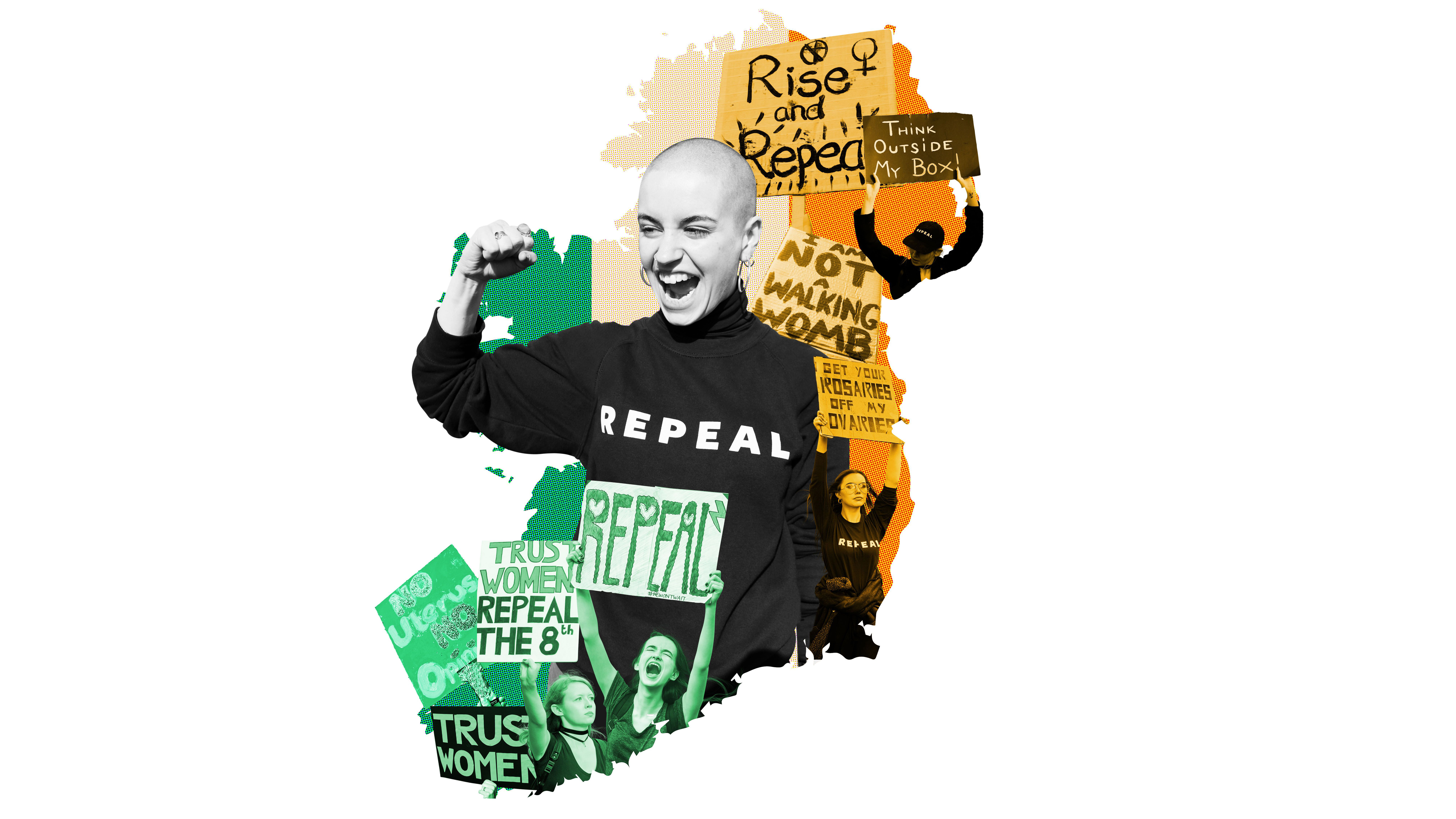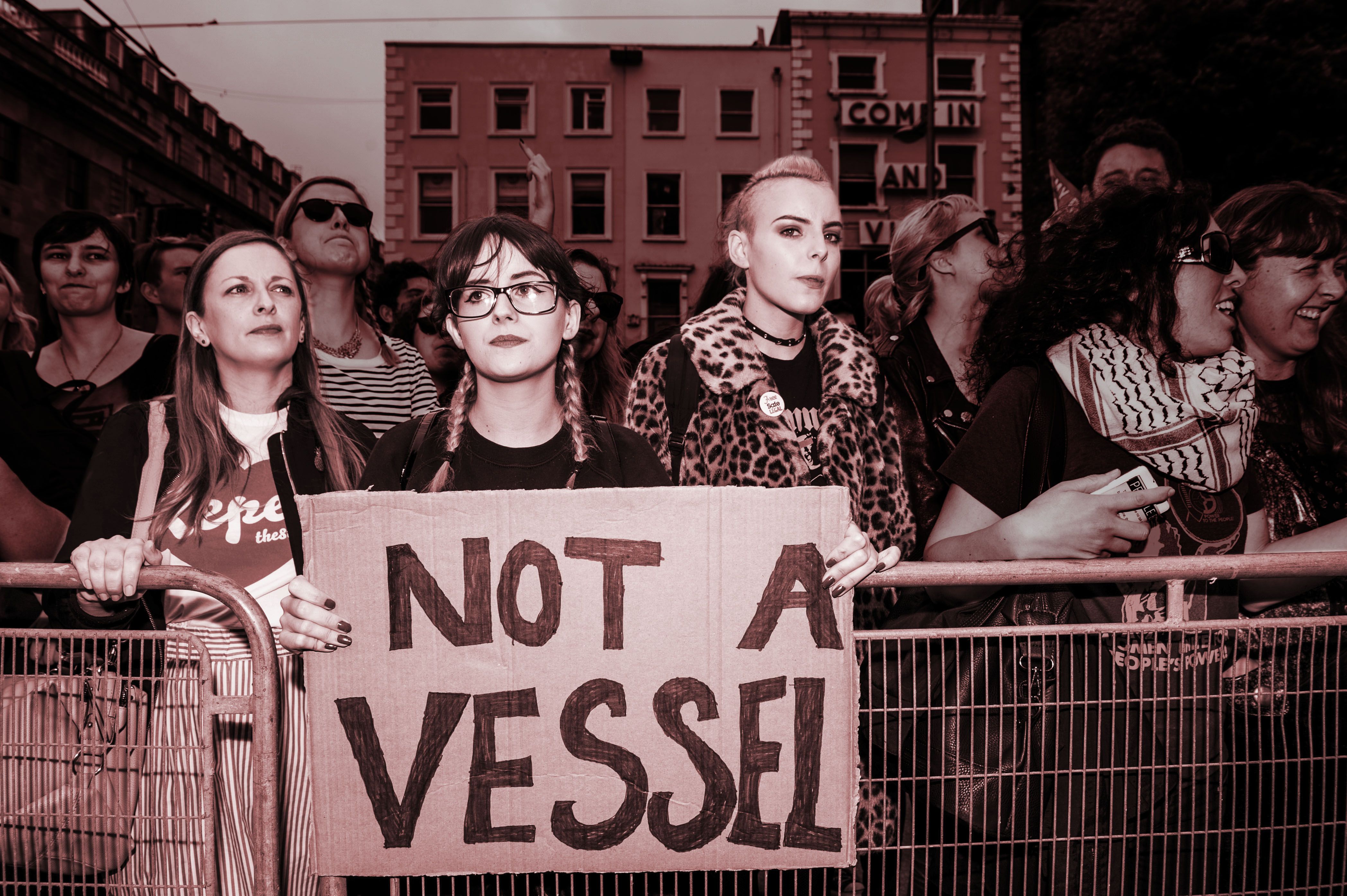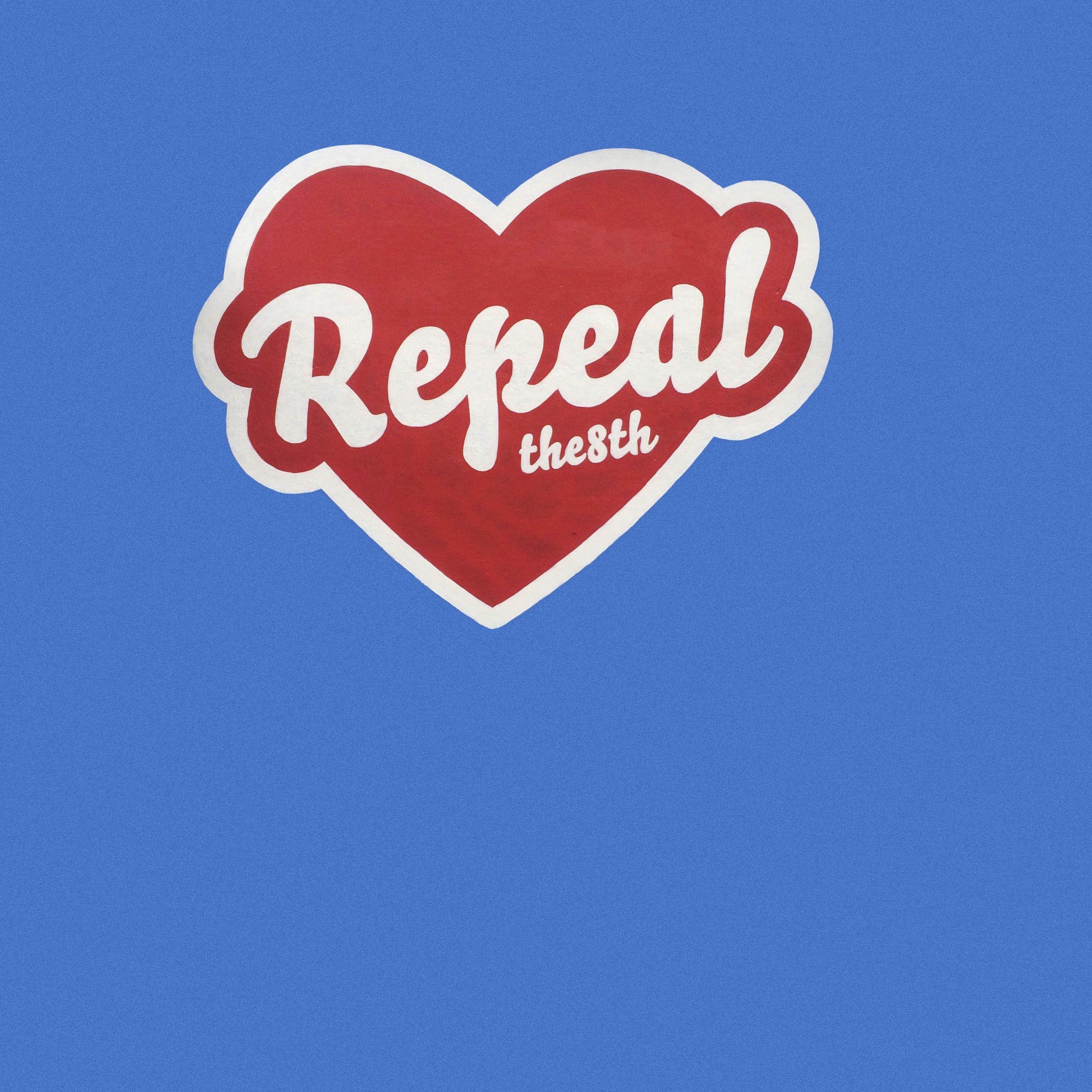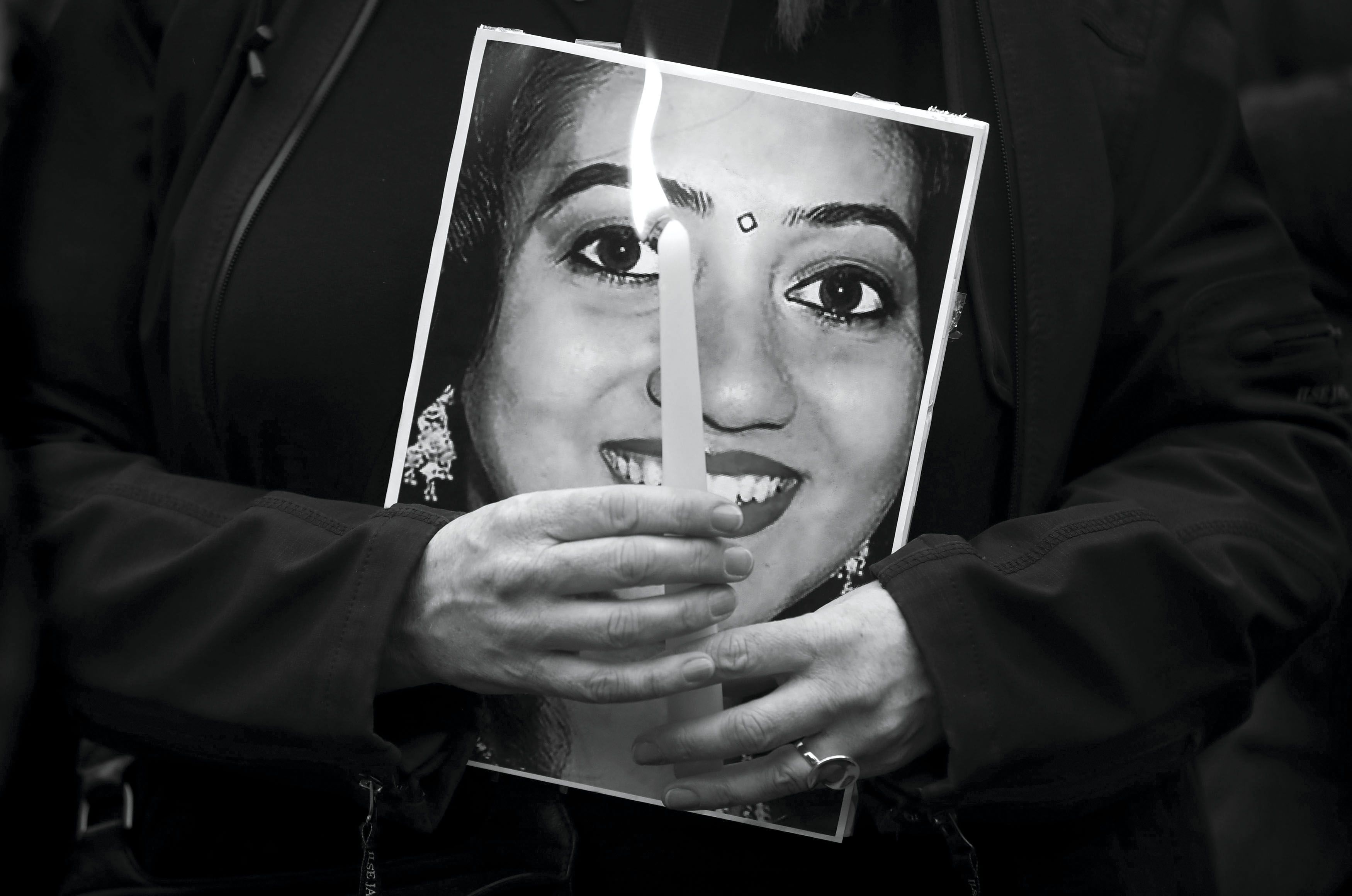Irish Women Want Their Bodies Back
Ireland is so rigidly anti-abortion, its law criminalizing the procedure is written into its constitution. On the eve of a referendum to repeal the ban, women are leading the charge to end reproductive restrictions that have endangered their health for nearly 100 years.

In the early morning darkness in the fall of 2011, Siobhan Donohue kissed her two sleeping children goodbye and left for Dublin Airport. Her flight to Liverpool, England, took off just as the sun began to glimmer across the runway. Seated among briefcase-carrying businessmen and rowdy bachelorette parties, Donohue clutched her stomach protectively, knowing on her return trip she would no longer be pregnant.
Just a week earlier, Donohue had sat ashen-faced in her doctor’s office during her 20-week checkup as she received the devastating diagnosis that the fetus she was carrying had anencephaly, a condition that prevents the brain from fully developing. Donohue, herself a doctor, understood the severity of the condition, remembering photographs of infants with half-developed skulls she’d seen during her schooling. “Most of these babies will either die before delivery or shortly after,” says Donohue, now 46. “When you hear this news about your child, everything is just gone—just like that, your whole reality is turned upside down.” Knowing the likely outcome, Donohue decided to terminate her pregnancy. But doing so meant she had to leave the country.
Ireland bans abortion except when the mother’s life is at risk. A constitutional clause, Article 40.3.3—or the Eighth Amendment, as it’s known—“acknowledges the right to life of the unborn…and guarantees in its laws…to defend and vindicate that right,” criminalizing women who seek the procedure. Although there are no known cases of anyone being prosecuted, procuring an abortion carries a 14-year prison term.
Approximately 4,000 Irish women travel to a foreign country each year to have an abortion.
Under the law, once Donohue decided to have an abortion, her doctor had to relinquish care, leaving her on her own to make the arrangements. The trip and procedure cost about $4,000, an unduly high amount for many women in similar situations. According to the Center for Reproductive Rights, a global legal-advocacy organization, approximately 4,000 Irish women travel to a foreign country each year to have an abortion. The most common destination is the U.K., with more than 3,200 Irish women seeking abortions there in 2016. “Ireland can export its abortion problem, but prohibitive laws don’t prevent the problem,” says Ailbhe Smyth, who has fought for abortion rights for more than 40 years. “It hasn’t worked anywhere in the world.”
But in March, in an unprecedented cultural shift, following six years of annual protests during which thousands have taken to the streets of Dublin to march against the law, the taoiseach (Ireland’s term for prime minister), Leo Varadkar, who is the country’s youngest and first-ever openly gay head of government, announced that a vote on whether or not to repeal the law will be held on May 25. If a majority votes for repeal, it would allow for the passage of a new law permitting women access to abortion until the 12th week of pregnancy or later in exceptional circumstances.

Pro-choice campaigners counter-protest at the annual anti-abortion All Ireland Rally for Life in Dublin, 2017.
Ireland is one of seven European countries (along with Poland, Cyprus, Malta, and microstates Andorra, Liechtenstein, and San Marino) where abortion is restricted to the point of being mostly illegal, and the only one to have a ban written into its constitution. In Northern Ireland, which is a separate country from Ireland and part of the U.K., a ban on abortion in almost all circumstances has been maintained, even though the rest of Britain legalized the procedure in 1967 and its National Health Service covers the cost. (Last year, the U.K. government agreed to pay for abortions for women from Northern Ireland if they can travel to England, Scotland, or Wales.) “Ireland is extremely unusual,” says Leah Hoctor, European regional director of the Center for Reproductive Rights. “There are very few countries that have constitutional provisions regulating abortion.”
Unwed mothers were subjected to forced labor and physical abuse as punishment.
It’s never been completely legal to terminate a pregnancy in Ireland. When the country gained independence from the U.K. in 1922, a statute known as the Offenses Against the Person Act—which stated that any woman with intent to “procure her own miscarriage…shall be liable...to be kept in penal servitude for life”—remained in effect. Ireland was very much under the control of the Catholic Church for decades afterward, and there was a “secrecy and stigma surrounding anything having to do with sex or reproduction,” according to Smyth. The sale of contraception was banned in Ireland until 1980; once legal, it was available only by prescription to married couples for family-planning purposes.
Get exclusive access to fashion and beauty trends, hot-off-the-press celebrity news, and more.
Unmarried women were often sent to church-run Mother and Baby Homes to hide a scandalous pregnancy from public view; the mothers were forced to live and work at the institutions for up to two years and were almost never allowed to keep their children, with the majority ending up in “industrial schools”—Catholic-run homes for orphans—or adopted by families in England, Germany, or the U.S. (In 2017, on the grounds of a former Mother and Baby Home in Tuam, a mass grave inside a septic tank was discovered; it contained the remains of nearly 800 babies and toddlers born to unmarried mothers.) After two years, if the unwed mothers weren’t welcomed back home by their families, they were sent to Magdalene laundries, institutions also known as Magdalene asylums for “fallen women,” where they were subjected to forced labor (typically washing clothes and bedding) and physical abuse as punishment for their promiscuity. The last Magdalene laundry closed in 1996.
Despite the existing law banning abortion, when the Roe v. Wade ruling legalized the procedure in the U.S. in 1973, hard-line Catholics worried the same thing could happen in Ireland if they didn’t enact a constitutional mandate. A group of anti-abortion and right-wing Catholic organizations joined to form the Pro-Life Amendment Campaign and curried favor with legislators by sending postcards that read “Where have all our children gone? Abortion kills.” In 1983, the Eighth Amendment easily passed, with 67 percent of voters in favor.
Ireland is a different place today. Thanks to low corporate-tax rates that attract multinational companies, the country has been transformed into a technology hub with a well-educated, multicultural workforce. At the same time, rocked by child-abuse scandals, the Catholic Church has seen its influence wane. While 78 percent of the population still identifies as Catholic, church attendance has dwindled. The most dramatic shift away from the church’s teachings came in May 2015, when Ireland became the first country to legalize same-sex marriage by popular vote. The months leading up to the referendum were colorful, with rainbow flags dotting the streets and people wearing clothes with yes printed across their chests. Droves of emigrants returned home to cast ballots, and those who couldn’t appealed to voters back home with the hashtag #BeMyYes on Twitter.
The amendment was approved by 62 percent of voters, setting the stage for abortion as the next fight. “After the marriage-equality referendum, there was this closer examination of the church’s hold over Irish people,” says Anna Cosgrave, a Dublin-based pro-choice activist. “I think people felt very motivated and quite charged—they had a bit of outrage.”
The repeal movement was also galvanized by some high-profile tragic cases. One of the first, in 2012, was Indian-born Savita Halappanavar, a 31-year-old dentist, who was admitted to the hospital for a miscarriage that unfolded over the course of a week. When it became clear the fetus would not survive, Halappanavar asked for an abortion but was denied because the fetal heartbeat was still detectable. Both the fetus and Halappanavar died from septic shock, and at the inquiry into her death, a doctor said Halappanavar would likely still be alive had she been allowed a termination when she first requested it. Candlelight vigils took place across the country, and angry protesters congregated at parliament.
Halappanavar would likely still be alive had she been allowed a termination when she first requested it.
Similar outcries erupted in December 2014 after the devastated family of a pregnant woman in her 20s, who had suffered brain trauma and was clinically dead, had to get a court order to take her off life support. The unnamed woman, who was 18 weeks pregnant, had been kept alive artificially, because her doctors feared the potential legal consequences of allowing her fetus to die with her. (Doctors face 14-year prison sentences for illegally terminating pregnancies, though none have been prosecuted.)
And then there’s the 2011 case of Amanda Mellet, a now 44-year-old woman from Dublin, who learned at 22 weeks her fetus had an abnormality that would cause it to die in the womb or shortly after birth. After deciding she couldn’t continue with the pregnancy, Mellet and her husband, James, flew to Liverpool for an abortion. Mellet had an adverse reaction to pain medication, which left her weak, bleeding, and struggling not to faint on the flight back to Dublin the next day. In 2013, the Center for Reproductive Rights filed a complaint against Ireland on Mellet’s behalf before the U.N. Human Rights Committee in Geneva, arguing that the country’s abortion laws violated her human rights by “subjecting her to severe mental suffering and anguish.” Her lawyers noted she had been denied adequate postabortion care and bereavement counseling typically offered to women with nonviable pregnancies, and that the stigma associated with abortion, along with the obstacles she faced in getting information about the medical options open to her, aggravated her suffering. “How can it be justified that a pregnant woman must sneak over to England like a criminal to do what she feels is the most humane thing?” Mellet said in a statement at the time.

A mural painted on a wall in the Temple Bar district of Dublin was removed by authorities, prompting cries of censorship in 2016.
Three years later, in June 2016, the committee issued a unanimous ruling that found in prohibiting Mellet from accessing an abortion, Ireland had “violated her right to be free from cruel, inhumane, or degrading treatment, as well as her right to privacy.” They urged the country to redress the harm Mellet suffered and reform its laws to ensure other women would not face similar violations of their rights. The Irish government paid Mellet €30,000 (about $37,000 today) in compensation. While the ruling isn’t enforceable by law, it sent a clear message and embarrassed the Irish government.
Back in 2012, Anna Cosgrave was nearing graduation from university and was looking for work when she came across stories of Halappanavar’s death and felt she couldn’t “just sit outraged behind my computer screen.” She attended a candlelight vigil but wanted to do more to take “the conversation offline and onto the streets.” She remembered the yes shirts from the gay-marriage campaign and thought those opposing the Eighth Amendment could use their own unifying article of clothing. She kept it simple, designing a plain black sweatshirt with repeal emblazoned in white across the front, and began selling them online. The sweatshirts proved to be a powerful form of silent protest, much like the pink “pussy hats” seen during the Women’s March in the U.S. and elsewhere. “I had no idea how to run an online store,” says Cosgrave, 28. But the orders kept coming, so before long she formally launched the Repeal Project with the tagline “Outerwear to give voice to a hidden problem.”
The sweatshirts have become a common sight on the streets of Dublin. Last year they even made an appearance in Ireland’s parliament when six opposition leaders—four men and two women—took off their jackets to reveal the shirts during a debate on the Eighth Amendment. They’ve also helped women feel comfortable sharing their stories. Cosgrave recalls hearing from one woman who said that, before the sweatshirts, she had never told anyone she had traveled to the U.K. for an abortion. “She’d kept it secret,” Cosgrave says. “But her workplace brought in repeal sweatshirts, and seeing her colleagues wear them empowered her to open up to them.”
Historically, abortion in Ireland was discussed in abstract medical and theological terms. But the bravery of women telling their personal stories helped humanize the movement. One of the first prominent women to share her experience was comedian and actress Tara Flynn. Onstage at an Amnesty International abortion-rights event held at a music festival in 2015, Flynn recounted how traveling to the Netherlands in 2006 for an abortion made her feel stigmatized and isolated. Going public was both “liberating and terrifying,” she says. But it’s important to “change the conversation on abortion from a taboo to something that impacts ordinary women, not criminals. It’s the woman at your bus stop.” Despite the attacks she gets from pro-lifers online, she’s glad she spoke out. “There is something about living your truth,” says Flynn, 48. “I felt you can’t say you are honestly campaigning without disclosing your situation.”

A woman holds a candle at a vigil marking the fifth anniversary of the death of Savita Halappanavar, who died after she was denied an abortion, 2017.
Women are showing their support in other ways, too. Andrea Horan, the owner of Tropical Popical nail salon in Dublin, became an activist when she started discussing reproductive rights with her clients. Soon, customers were requesting political nail art, like hot-pink "8"s—an especially popular design. “I was looking at the communications of the repeal campaign, and nothing really touched me,” she says. “All the girls in the nail bar...it wasn’t even something they knew about, and I thought, There has to be a way to mobilize the girls to care.” Her shop has also sold “Healthcare Not Airfare” luggage tags.
Soon, customers were requesting political nail art, like hot-pink "8"s.
In July 2016, Horan, 37, commissioned a street artist to paint a mural in Dublin’s trendy Temple Bar district. The painting—a red heart with “Repeal the 8th” in white across the middle—was removed after authorities received complaints. But the removal sparked cries of censorship, and the heart became the unofficial logo of the campaign, reproduced on prints, bags, jewelry, even doughnuts. “At the time, it was devastating,” Horan says of the mural’s removal. “But the attention it got in coming down was amazing—it kicked things off.”
This past September, the annual March for Choice was the largest since the Abortion Rights Campaign, an alliance of pro-choice groups, began hosting the rallies in 2011. By some estimates, 30,000 people took to the streets (up from 20,000 in 2016), hopeful this would be the last time they’d have to gather for the cause. The buoyant crowd, peppered with black repeal sweatshirts, snaked its way through Dublin’s streets chanting, “Pro-life, that’s a lie, you don’t care if women die” and “Get your rosaries off my ovaries.”
In February, a public-opinion poll conducted by the British research firm Kantar Millward Brown showed 63 percent of Irish voters favor repealing the Eighth Amendment, a reality that Smyth, the longtime rights activist, says would have been “unthinkable” even a year ago. “Repeal would simply not be on the political agenda if the campaign was not there,” she says. “When they hear women’s experiences, they change their minds.” Get-out-the vote efforts are under way on social media with a #HomeToVote hashtag encouraging citizens living elsewhere to return to cast ballots. Regardless of the outcome, Irish women, wielding newfound confidence in standing up to the Catholic Church’s long-standing control over their bodies, will no longer be silenced or shamed for their reproductive decisions. “Now we feel empowered—like we can make change happen!” says Flynn. “The snowball has started rolling down the hill, and there is no pushing it back up.”
This story originally appeared in the May issue of Marie Claire, on newsstands now.
Lead image: Illustration by Susanna Hayward. Clockwise from top left: Lisa Connolly; Mark Henderson/Alamy; Clodagh Kilcoyne/Reuters; Mark Henderson/Alamy; Nurphoto/Getty Images; Fabrice Jolivet Photographer/Alamy; Glodagh Kilcoyne/Reuters; Mark Henderson/Alamy